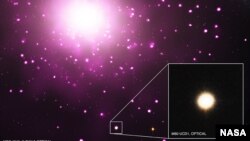An “ultra-compact dwarf galaxy” has been spotted by astronomers.
The galaxy, known as M60-UCD1, has its entire mass in a radius of only 80 light years, compared to the Milky Way’s radius of 50,000 light years. That means the density of stars is about 15,000 times greater than the Milky Way, and the stars are about 25 times closer.
"Traveling from one star to another would be a lot easier in M60-UCD1 than it is in our galaxy," said Jay Strader of Michigan State University in Lansing, first author of a new paper describing these results. "But it would still take hundreds of years using present technology."
Scientists hope M60-UCD1, which has the mass of 200 million suns, can provide clues on how galaxies evolved.
M60-UCD1 was seen by NASA’s Hubble Space Telescope and follow up observations were made with NASA’s Chandra X-ray Observatory and ground-based optical telescopes.
The galaxy is believed to have abundant amounts of heavy elements – elements heavier than hydrogen and helium – which makes it a “fertile environment for planets and, potentially, life to form,” said co-author Anil Seth of the University of Utah.
Another intriguing aspect of M60-UCD1 is that the Chandra data reveal the presence of a bright X-ray source in its center. One explanation for this source is a giant black hole weighing in at some 10 million times the mass of the Sun.
"We think nearly all of the stars have been pulled away from the exterior of what once was a much bigger galaxy," said co-author Duncan Forbes of Swinburne University in Australia. "This leaves behind just the very dense nucleus of the former galaxy, and an overly massive black hole."
If that happened, the galaxy would have been 50 to 200 times more massive than it is now.
Researchers believe the galaxy is more than 10 billion years old and that it has been “stalled” at this size for several billion years, and it is about 60 million light years from Earth.
A paper on M60-UCD1 has been published in the September 20th issue of The Astrophysical Journal Letters.
The galaxy, known as M60-UCD1, has its entire mass in a radius of only 80 light years, compared to the Milky Way’s radius of 50,000 light years. That means the density of stars is about 15,000 times greater than the Milky Way, and the stars are about 25 times closer.
"Traveling from one star to another would be a lot easier in M60-UCD1 than it is in our galaxy," said Jay Strader of Michigan State University in Lansing, first author of a new paper describing these results. "But it would still take hundreds of years using present technology."
Scientists hope M60-UCD1, which has the mass of 200 million suns, can provide clues on how galaxies evolved.
M60-UCD1 was seen by NASA’s Hubble Space Telescope and follow up observations were made with NASA’s Chandra X-ray Observatory and ground-based optical telescopes.
The galaxy is believed to have abundant amounts of heavy elements – elements heavier than hydrogen and helium – which makes it a “fertile environment for planets and, potentially, life to form,” said co-author Anil Seth of the University of Utah.
Another intriguing aspect of M60-UCD1 is that the Chandra data reveal the presence of a bright X-ray source in its center. One explanation for this source is a giant black hole weighing in at some 10 million times the mass of the Sun.
"We think nearly all of the stars have been pulled away from the exterior of what once was a much bigger galaxy," said co-author Duncan Forbes of Swinburne University in Australia. "This leaves behind just the very dense nucleus of the former galaxy, and an overly massive black hole."
If that happened, the galaxy would have been 50 to 200 times more massive than it is now.
Researchers believe the galaxy is more than 10 billion years old and that it has been “stalled” at this size for several billion years, and it is about 60 million light years from Earth.
A paper on M60-UCD1 has been published in the September 20th issue of The Astrophysical Journal Letters.












